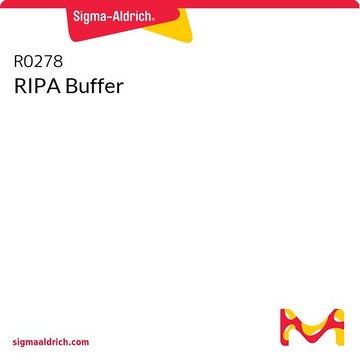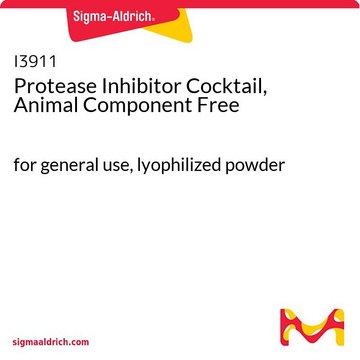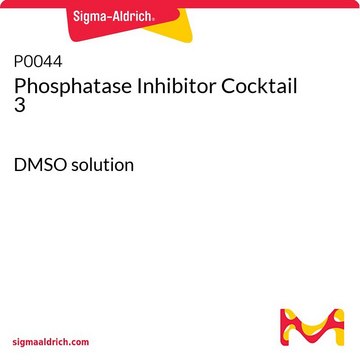I3786
Protease Inhibitor Cocktail
Animal-Free, DMSO solution, for the inhibition of serine, cysteine, aspartic proteases and aminopeptidases, for use with mammalian cell and tissue extract, DMSO solution
Sinônimo(s):
Protease inhibitor
Faça loginpara ver os preços organizacionais e de contrato
About This Item
Código UNSPSC:
12352200
NACRES:
NA.77
Produtos recomendados
Nome do produto
Protease Inhibitor Cocktail, Animal Component Free, for use with mammalian cell and tissue extract, DMSO solution
Nível de qualidade
Formulário
DMSO solution
solubilidade
water: soluble
temperatura de armazenamento
−20°C
Procurando produtos similares? Visita Guia de comparação de produtos
Descrição geral
Components of this cocktail are of non-animal origin and no animal products were used in the component production process. All vessels and instruments used for the cocktail production are dedicated for animal component free production and have never encountered an animal product. Aprotinin used in this cocktail is a recombinant bovine protein expressed in plants (Nicotiana).
This protease inhibitor cocktail has been optimized and tested for mammalian cell and tissue extracts.
Especificidade
Inhibits serine, cysteine, aspartic proteases, and aminopeptidases.
Aplicação
Animal component free (ACF). Optimized and tested for general use. Can also be used for purification of histidine-tagged proteins, as chelating agents have been omitted.
Componentes
AEBSF
Aprotinin
Bestatin
E-64
Leupeptin
Pepstatin A
Aprotinin
Bestatin
E-64
Leupeptin
Pepstatin A
forma física
The components in this ACF protease inhibitor cocktail do not originate from animal sources and can thus be used in the production of animal-free proteins.
This ACF cocktail is supplied as a ready-to-use solution in DMSO. One ml of the cocktail solution is recommended for the inhibition of endogenous enzymes found in 100 mL of lysate from 20 g (wet weight) of bovine liver, or 10 mL of cell lysate obtained from CHO cells at a cell density of 108 cells per mL.
Palavra indicadora
Warning
Frases de perigo
Declarações de precaução
Classificações de perigo
Eye Irrit. 2 - Skin Irrit. 2
Código de classe de armazenamento
10 - Combustible liquids
Classe de risco de água (WGK)
WGK 2
Ponto de fulgor (°F)
188.6 °F - closed cup
Ponto de fulgor (°C)
87 °C - closed cup
Escolha uma das versões mais recentes:
Já possui este produto?
Encontre a documentação dos produtos que você adquiriu recentemente na biblioteca de documentos.
Os clientes também visualizaram
Gold nanoparticles do not induce myotube cytotoxicity but increase the susceptibility to cell death.
Paulo Emílio Corrêa Leite et al.
Toxicology in vitro : an international journal published in association with BIBRA, 29(5), 819-827 (2015-03-21)
Gold nanoparticles (AuNP) have been widely used for many applications, including as biological carriers. A better understanding concerning AuNP safety on muscle cells is crucial, since it could be a potential tool in the nanomedicine field. Here, we describe the
Yue Gao et al.
Biomedicine & pharmacotherapy = Biomedecine & pharmacotherapie, 129, 110396-110396 (2020-06-25)
Systemic lupus erythematosus (SLE) is an autoimmune disease that is mainly caused by excessive accumulation of autoantibodies that target autoantibodies such as nucleic acids. T helper (Th) cell have been associated with the development of SLE. Typically, different subsets of
Wimonrat Panpetch et al.
Frontiers in immunology, 11, 561652-561652 (2020-10-27)
Obesity induces gut leakage and elevates serum lipopolysaccharide (LPS), a major cell wall component of Gram-negative bacteria, through gut translocation. Because Candida albicans is prominent in human gut but not in mouse, C. albicans, a source of (1→3)-β-D-glucan (BG) in
Mo Shen et al.
Molecular medicine reports, 16(1), 937-942 (2017-06-07)
The role of inflammation in tumorigenesis and development is currently well established. Lymphotoxin β receptor (LTβR) activation induces canonical and noncanonical nuclear factor (NF)‑κB signaling pathways, which are linked to inflammation‑induced carcinogenesis. In the present study, 5,637 bladder cancer cells were
Jasim Khan et al.
Toxicology, 428, 152299-152299 (2019-10-02)
Bisphenol A (BPA) is a ubiquitously distributed endocrine disrupting chemical (EDC). BPA exposure in humans has been a matter of concern due to its increased application in the products of day to day use. BPA has been reported to cause
Nossa equipe de cientistas tem experiência em todas as áreas de pesquisa, incluindo Life Sciences, ciência de materiais, síntese química, cromatografia, química analítica e muitas outras.
Entre em contato com a assistência técnica














